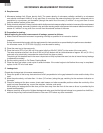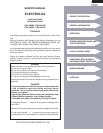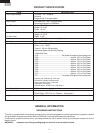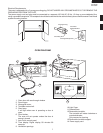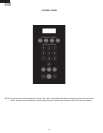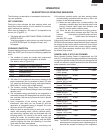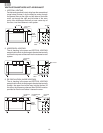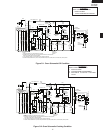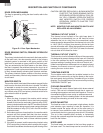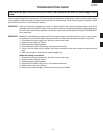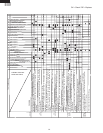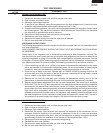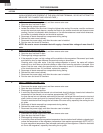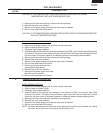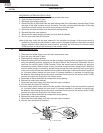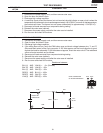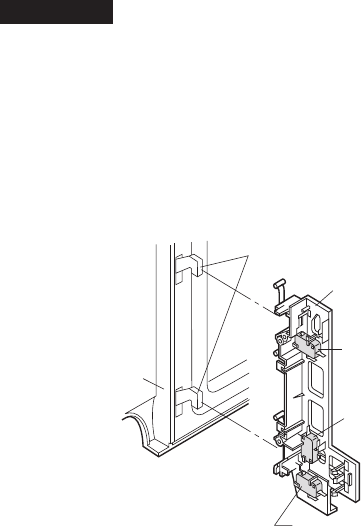
12
FMV156DBE
FMV156DSE
FMV156DQE
FMV156DCF
DESCRIPTION AND FUNCTION OF COMPONENTS
vapors given off from the heating foods. It is then exhausted
through the exhausting air vents at the oven cavity.
HOOD
FAN MOTOR
The hood fan motor is a one-speed, single-phase, double
pole induction type, requiring a hood fan capacitor. It is
located outside the upper rear part of the oven cavity, is
to remove, from around the oven, hot air rising from the
conventional electric or gas range over which it is installed.
This air is then expelled either vertically or horizontally
through the customer supplied duct system, or discharged
back into the kitchen.
HOOD LAMP
The hood lamps are mounted at the hood lamp angle on
the base cover. The hood lamps can be turned off and on
Latch hook
Door sensing
switch
Latch heads
Monitor switch
Primary interlock switch
Door
DOOR OPEN MECHANISM
The door is opened by pulling the door handle, refer to the
Figure D-1.
CAUTION: BEFORE REPLACING A BLOWN MONITOR
FUSE TEST THE DOOR SENSING SWITCH,
SECONDARY INTERLOCK RELAY (RY2), RE-
LAY (RY1), PRIMARY INTERLOCK SWITCH
AND MONITOR SWITCH FOR PROPER
OPERATION. (REFER TO CHAPTER "TEST
PROCEDURE").
NOTE: MONITOR FUSE AND MONITOR SWITCH ARE
REPLACED AS AN ASSEMBLY.
THERMAL CUT-OUT (HOOD )
This thermal cut-out located on the right base plate. It
is designed to automatically turn on the hood fan motor
whenever the hot air rising from the conventional range
below causes the temperature at the thermal cut-out to rise
to 140
O
F (60
O
C) or higher, thus removing this hot air from
around microwave oven. When the temperature around the
thermal cut-out drops to 113
O
F (45
O
C) or lower, the thermal
cut-out shuts off the hood fan motor.
THERMAL CUT-OUT (CAVITY )
This thermal cut-out is located on the top of the oven cavity.
It is designed to prevent damage to the oven unit if the food
in the oven catches fire due to overheating produced by
improper setting of cooking time or failure of control unit.
Under normal operation, the thermal cut-out remains closed.
However, the thermal cut-out will open at 293
O
F (145
O
C)
causing the oven to shut down.
TURNTABLE MOTOR
The turntable motor rotates the turntable located on the
bottom of the oven cavity, so that the foods on the turnta-
ble cook evenly during cooking. Turntable will turn in either
direction. The turntable motor can be turned off by touching
TURNTABLE ON/OFF pad.
COOLING FAN MOTOR
The cooling fan motor drives a blade which draws external
cool air. This cool air is directed through the air vanes sur-
rounding the magnetron and cools the magnetron. This air is
channelled through the oven cavity to remove steam and
Figure D-1. Door Open Mechanism
DOOR SENSING SWITCH, PRIMARY INTERLOCK
SWITCH
The primary interlock switch is mounted in the lower position
of the latch hook, the door sensing switch in the primary
interlock system is mounted in the upper position of the
latch hook is mounted on upper position of the latch hook.
They are activated by the latch heads on the door. When
the door is opened, the switches interrupt the circuit to all
components. A cook cycle cannot take place until the door
is firmly closed thereby activating both interlock switches.
The primary interlock system consists of the door sensing
switch and secondary interlock relay located on the control
circuit board.
MONITOR SWITCH
The monitor switch is activated (the contacts opened) by the
latch head on the door while the door is closed. The switch
is intended to render the oven inoperative, by means of
blowing the monitor fuse, when the contacts of the second-
ary interlock relay (RY2) and primary interlock switch fail to
open when the door is opened.
Functions:
1. When the door is opened, the monitor switch contact
close (to the ON condition) due to their being normally
closed. At this time the secondary interlock relay (RY2),
primary interlock switch are in the OFF condition (contacts
open) due to their being normally open contact switches.
And the contacts of relay (RY1) are in the ON condition
(contacts close).
2. As the door goes to a closed position, the monitor switch
contacts are first opened and then the door sensing
switch and the primary interlock switch contacts close.
(On opening the door, each of these switches operate
inversely.)
3. If the door is opened, and the secondary interlock relay
(RY2) and primary interlock switch contacts fail to open,
the monitor fuse blows simultaneously with closing of the



